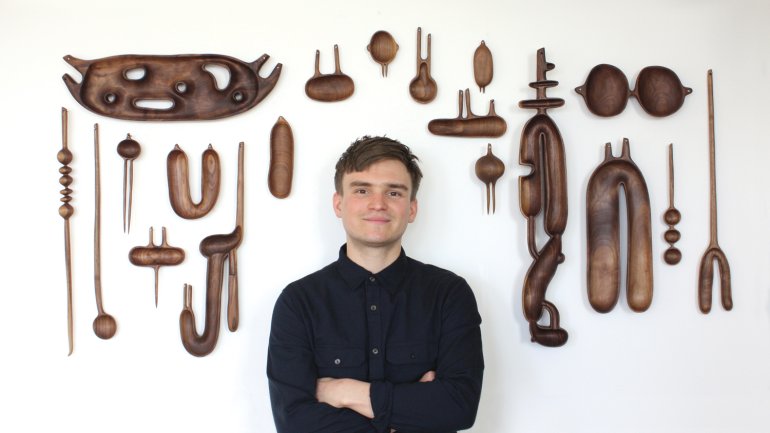Julian Watts
Julian Watts
Woodcarver Julian Watts never touched the stuff as a sculpture major at the University of Oregon, where he earned his BFA in 2012. “The program was more experimental and cerebral than technical or craft-based,” says Watts, 27. “Some of my installations involved healthy quantities of pink goo,” he adds with a smile. “But I think I was mapping out my future direction.”
Watts’ immediate journey after college was back home to San Francisco, where he found work in a furniture woodshop specializing in tables. Performing rote tasks at first, he mastered increasingly sophisticated techniques and eventually was able to trade hours for studio space within the shop “and finally return to making some kind of art.”
Watts began collecting free scraps of wood from around the shop, inspired by a two-day spoon-carving workshop he’d taken back in college. “Then I took out my gouges and basically went at it, learning as I went along.” As Watts became more comfortable and proficient with the process, his sculptural training began to assert itself, and functional objects such as bowls and spoons started to morph, turning increasingly more fantastical and conceptual.
“Yeah, they started to get weird pretty quickly,” recalls Watts. “Once I had the basic skills down, I wanted to express ideas I’d been carrying around, and I started pushing the form.” Hence, at a show last April at Heath Ceramics in San Francisco, there were conjoined vessels that suggest lungs as much as bowls, platters that closely resemble a lunar landscape, and utensils that seem to have sprouted strange, even menacing, appendages. Beautiful to behold, the pieces also challenge viewers’ perceptions, as many of these seemingly domestic objects are more suggestive of the surreal stuff of dreams than the contents of a kitchen drawer.
As Watts pulls from ideas that have been in his head since art school, his experience as a furniture maker helps fuel his process. Every object starts as an abstract scribble in his sketchbook, which he transfers directly onto the wood. “I always try to fit in as many pieces as possible, and then the ideas continue to change and evolve as I carve, depending upon the grain and the shape of the wood,” he explains.
Thanks to the magic of Instagram, last year Watts’ work caught the eye of artist and furniture legend Tyler Hays, who now shows Watts’ work (including his recent handcarved sculptural utensils in bleached maple) at his BDDW showrooms in New York and Milan. And, in a kind of full circle, Watts is envisioning a future where the market for his “pretty, expensive objects” allows him to revisit the making of more conceptual (and less static) installations: “It may be a lifelong process, balancing aspects of ‘art’ and ‘craft’ that sometimes overlap and sometimes pull away from each other – and following where that takes me.”
Familiar and Strange
Chip off the old block: As a child, Watts used to gather twigs and chunks of roots for his father, illustrator and sculptor James K.M. Watts, whose three-dimensional work melds organic matter with thick patinas of oxidized metal paint.
Also inspired by: Watts cites disparate influences such as folk art and the sculptures of Cy Twombly and Karla Black. But nature, the human body, and everyday utilitarian objects remain primary and ongoing references.
And the Brothers Grimm: Watts’ other obsession in college was folklore and folk tales, realms in which the familiar can quickly turn menacing. “These stories dredge up disturbing, problematic themes from our subconscious, and in a similar way, I wanted to put some of these weird, strange images into items that we take for granted.”

